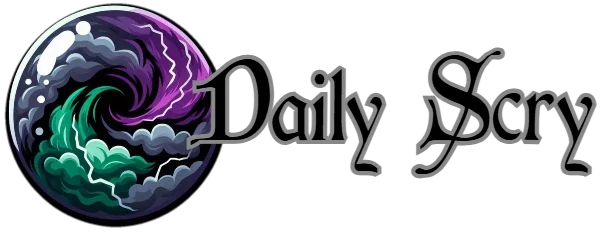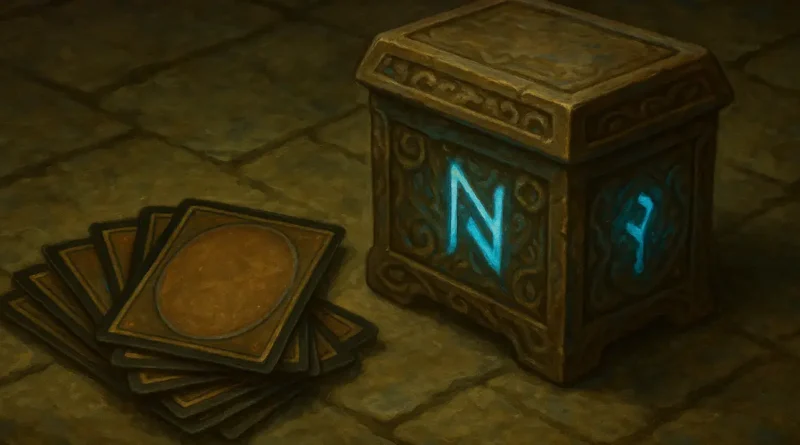Guide To Building Your First Commander Deck
When I first made the leap to the exciting world of commander, I came from Arena’s Standard queues and a couple of Games Night starter decks. Going from a relatively limited pool of cards to pretty much every card to have ever been printed felt like quite the jump. Before commander, I hadn’t even encountered colorless mana before (thanks, Sol Ring). It was a steep learning curve, and honestly, pretty intimidating at first.
Building your first Commander deck can feel like staring up at a mountain. Unlike formats like standard, you’re not working with 60 cards – with up to four copies of each card – you’re crafting a full 100-card singleton deck centered around a legendary creature. That’s a lot of moving pieces, especially if your Magic background has been smaller formats or starter products.
The good news is you don’t have to climb that mountain all at once. This guide will walk you through the steps of building a solid first deck, from choosing your commander to balancing your card types, shaping your mana curve, and keeping your strategy on track. Along the way, I’ll share some personal mistakes I made early on – and how you can avoid them.
If you’ve ever asked yourself “How do I even start building my first Commander deck?”, this is the guide for you. But before we start, I have an important question for you…
Are you sure you want to build a commander deck from scratch?
To play commander, you’ll need a deck. However, building one from scratch isn’t your only option. You could start with a preconstructed Commander deck (often referred to as a “precon”). Both options have pros and cons, so to kick things off, I’ll help you make this crucial first decision.
Why Start With a Precon?
- Ready to Play Right Away – Precons come as a full 100-card deck. You can sleeve it up and jump into a game immediately.
- Learn How Commander Decks Are Built – They’re put together with a clear strategy, so you’ll see how ramp, draw, removal, and win conditions are balanced.
- Good Value – Many precons include staple cards like Sol Ring, Command Tower, and useful mana rocks that you’ll reuse in future decks.
- Easy to Upgrade – You can slowly swap out weaker cards for stronger ones without needing to build an entire list at once.
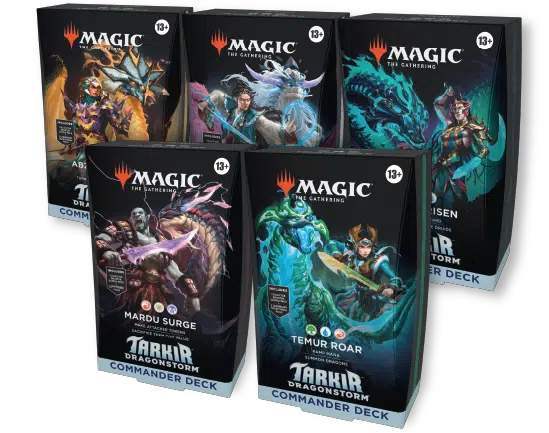
When I first started, I picked up a precon, and it was honestly the best decision. Coming from Standard and Arena, Commander was a whole new beast. That precon not only gave me a playable deck but also a clear example of what a Commander deck should look like.
Why Build From Scratch?
- Total Creative Freedom – You can choose any commander, any theme, and make it entirely your own.
- Deeper Understanding – You’ll learn more about card ratios, mana bases, and synergies by actually assembling everything yourself.
- More Personalized – Your deck will feel unique from the get-go, rather than starting from the same product as thousands of other players.
The downside is that it can be overwhelming. Commander decks have a lot of moving pieces, and if you haven’t played much outside starter sets, it’s easy to miss important elements like ramp or interaction.
My first scratch-built deck was Olivia, Crimson Bride, and I learned this the hard way. I built it assuming Olivia would always be there to cheat creatures out of the graveyard – but in reality, your commander isn’t always available. Sometimes you don’t have the mana, sometimes it gets removed, and sometimes the commander tax becomes too steep. Without backup plans, your deck can just stall out (and it very often did).
So which is the best option?
If you’re brand new, I’d recommend starting with a precon. Treat it like a training wheels deck – it’ll help you understand the fundamentals while giving you a safe starting point. Then, once you feel confident, you can start upgrading or even branch out into building your own creation from scratch.
Deciding what deck you want to build
If you’re still sure you want to build your first commander deck from scratch, the first thing you’re going to need to do is decide what kind of deck you want to build. The way I see it, there are probably three main avenues you’ll explore to make your decision.
Starting with a commander you like
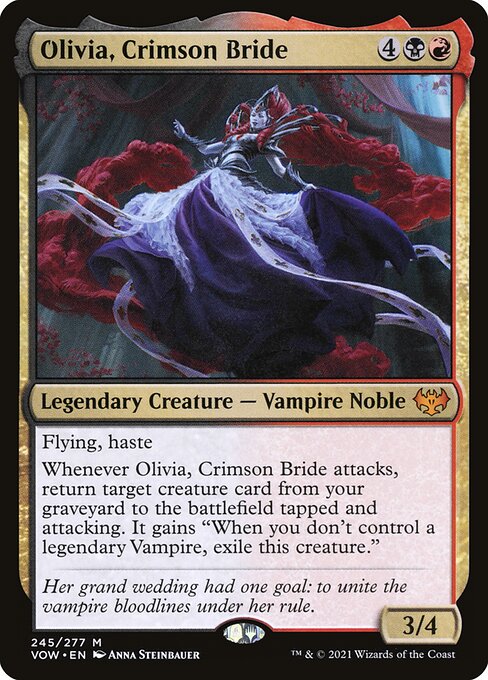
Sometimes the best place to start is with a single legendary creature that sparks your interest. Maybe it’s the art, the flavor text, or a cool ability you want to build around. Commander is unique in that your leader shapes not only your strategy but also your color identity (the colors you’re allowed to play).
When I built my Olivia, Crimson Bride deck, I did so for a couple of reason. Firstly, vampires are cool. Secondly, the game plan of getting big creatures into my graveyard and using my commander to bring them out swinging seemed like a lot of fun (and it is!).
Choosing an Archetype or Strategy First
However, I could have taken a different route. Sometimes you might know the kind of gameplay you want before you know which commander fits it. For example, do you want to:
- Go wide with a huge army of tokens?
- Control the board and grind out long games?
- Combo off and win in one explosive turn?
Once you’ve settled on a strategy, you can find a commander that best supports it. For example, if you want to swarm the board with tokens, Rhys the Redeemed (or pretty much any other elf commander, for that matter) or Adeline, Resplendent Cathar make perfect leaders. If you want to play the long control game, Narset, Enlightened Exile or Aminatou, the Fateshifter might be your style.
Picking a Color Identity
The final angle you might explore is that you like a particular color or combination of colors. Every commander has a color identity defined by the mana symbols in its cost and rules text (more on this in a second). This determines what cards you can include in your deck. For new players, this choice matters a lot:
- Mono-color decks (one color) are simpler to build – your mana base is cheap and consistent.
- Two-color decks give you more variety and flexibility without being overwhelming.
- Three or more colors open up tons of options but require more careful deckbuilding (and often pricier mana bases).
If this is your very first deck, start with one or two colors. It makes mana management much smoother and helps you learn the basics before juggling three or more.
Understanding Color Identity
One of the most important (and sometimes confusing) rules in Commander is color identity. Your commander doesn’t just lead your deck – it also decides what colors you’re allowed to play.
What Is Color Identity?
A commander’s color identity is made up of every mana symbol that appears in its mana cost and in its rules text.
- Atraxa, Praetors’ Voice has a mana cost of , so her color identity is green, white, blue, and black. You can’t play red cards in an Atraxa deck.
- Kenrith, the Returned King only costs to cast, but his activated abilities use all five colors of mana – so his color identity is actually five-color.
What Does That Mean For Your Deck?
- You can only include cards that match your commander’s color identity.
- Any mana symbols that don’t fit your commander’s colors are off-limits.
- Even hybrid mana cards (like ) count as both colors for deckbuilding purposes.
For instance, if your commander is Krenko, Mob Boss (mono-red), you can’t include Swords to Plowshares (white), or even Gruul Guildgate (which taps for red and green) because green isn’t part of Krenko’s identity.
The Basics of Deck Balancing
Ok, now you’ve chosen your commander and understand how color identities work, it’s time to choose the 99 cards in your deck. When I first started playing commander, 99 cards felt like a crazy amount of cards to have to pick. But, trust me, once you get going, that 99 fills up all too quickly.
This is where many new players get stuck – it’s tempting to cram in every cool card you own, but Commander decks work best when they’re balanced across a few core categories.
How Many Lands Should You Play?
A common rule of thumb is 36–38 lands in most Commander decks. Decks that run lots of mana rocks or ramp spells can get away with fewer, while slower or more color-hungry decks often need more.
It’s always tempting to cut a land for a flashy creature or splashy spell, but it comes back to bite you when you can’t hit your mana drops. One of my playgroup friends is notorious for running too few lands, and while it can be hilarious to watch, I can appreciate how frustrating it is when you don’t draw the lands you need. Trust me – having enough lands is the difference between playing the game and watching it happen.
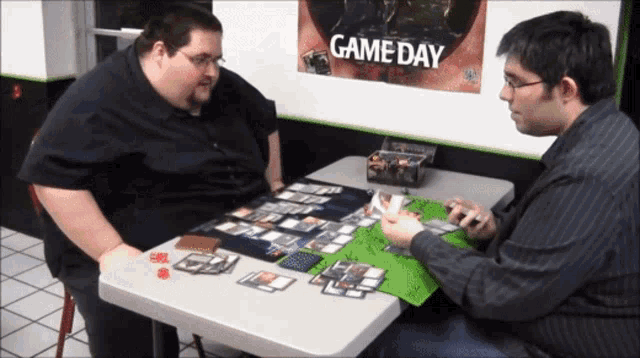
Ramp
Ramp is anything that helps you accelerate your mana beyond just playing one land per turn. Think Sol Ring, Cultivate, or mana dorks like Llanowar Elves. Most decks should aim for 8–12 ramp pieces, depending on your curve and colors. Green gets tons of ramp, but every color has options.
Card Draw
Commander games go long, and you’ll need to keep your hand full. Decks should generally include 8–12 card draw sources. Blue excels at drawing cards, but black’s life-for-cards tradeoffs (Phyrexian Arena, for example) and green’s “draw equal to creature power” effects are just as useful.
Removal and Interaction
Every deck needs ways to answer opposing threats – creatures, artifacts, enchantments, or even lands. Plan for 8–10 removal or interaction spells, mixing spot removal (such as Swords to Plowshares) with board wipes (such as Wrath of God). Skipping this category is one of the fastest ways to lose games, since you’ll have no answers to what your opponents are doing.
Creatures and Win Conditions
This is the flexible part. Some commanders want 30+ creatures (like tribal decks), while others only need a handful of key pieces. Whatever you choose, make sure you have a clear win condition – whether that’s combat damage, infinite combos, or draining life totals.
A Simple Ratio to Start With
Here’s a solid baseline you can tweak over time:
- 36–38 lands
- 8–12 ramp cards
- 8–12 card draw cards
- 8–10 removal/interaction
- 30–35 cards tied to your main strategy
- The rest: flexible slots for utility, flavor, or pet cards
If you keep this ratio in mind, your first deck will be both fun to play and consistent enough to actually do what it’s supposed to.
The Basics of Mana Curve
Another key part of deck building is your mana curve – the spread of card costs in your deck. Put simply, it’s how many one-drops, two-drops, three-drops, and so on you’re running.
Why Your Mana Curve Matters
In Commander, you only get one copy of each card that isn’t a basic land. That makes consistency harder to achieve compared to formats like Standard. A smooth mana curve helps ensure that you can actually play something meaningful every turn rather than sitting there waiting to hit six mana for your first impactful spell.
What a Good Curve Looks Like
- Early Turns (1–3 mana): You want plenty of plays here – mana rocks, ramp spells, or cheap creatures – to set yourself up for the mid-game.
- Mid Game (4–6 mana): This is your sweet spot. Most decks should load up on cards in this range, since this is when Commander games really come alive.
- Late Game (7+ mana): Big haymakers are fun, but too many of them will clog up your hand. Try to keep these to just a handful of cards unless your deck is specifically built to ramp into them quickly.
Avoiding “Top-Heavy” Decks
One of the easiest traps for new players is cramming in too many expensive cards. Big dragons, angels, and demons look amazing, but if your deck is full of them, you’ll often spend the first few turns doing nothing. That leaves you behind the rest of the table and makes it hard to recover.
A well-built deck should let you curve out smoothly, playing smaller cards early, impactful threats mid-game, and a few finishers later on.
A Trick For Checking Your Mana Curve
When you finish your first draft, lay the cards out by mana cost. You should see a nice “mana curve” shape – low early, peaking around 3–5 mana, then tapering off at the top end. If your pile of 7+ mana spells looks bigger than your 2–3 drops, you’re heading for trouble.
Building Around a Solid Strategy
Commander decks work best when they lean into a clear theme or gameplan. While you can certainly build a “good stuff” deck full of powerful cards, newer players will have a much better time if their deck has a focused identity.
The “30 Cards Rule”
A helpful rule of thumb is to include at least 30 cards that directly support your main strategy. For example:
- An Infect deck should pack about 30 cards that either have infect, proliferate, or amplify poison counters.
- A Zombie tribal deck should run 30+ zombies, zombie lords, or cards that generate zombie tokens.
- A Spellslinger deck should aim for 30 instants and sorceries or cards that reward you for casting them.
This ensures your theme shows up consistently in games. Without that density, your deck risks feeling disjointed and failing to “do the thing” it’s meant to.
Don’t Rely Only on Your Commander
Here’s a trap I fell into early on. As I’ve mentioned, my first scratch-built deck was Olivia, Crimson Bride. The whole plan revolved around using Olivia to reanimate big creatures from the graveyard. Sounds awesome, right? The problem was, if Olivia got removed (or I just didn’t have the mana to cast her), the deck basically ran out of steam.
I dealt with this by adding cards like Apprentice Necromancer and Feldon of the Third Path. These cards gave me a way to access the big nasties in my graveyard even when Olivia was out of action.
Supporting Your Strategy
Think of your deck as an engine. Your commander is one part of it, but you also need:
- Multiple ways of doing the same thing – other cards that mimic or back up your commander’s effect.
- Synergy pieces – cards that naturally work well with your strategy, even if they don’t look flashy.
- Backup plans – alternate paths to victory if your main plan falls apart.
Best Websites & Apps for Deck Building
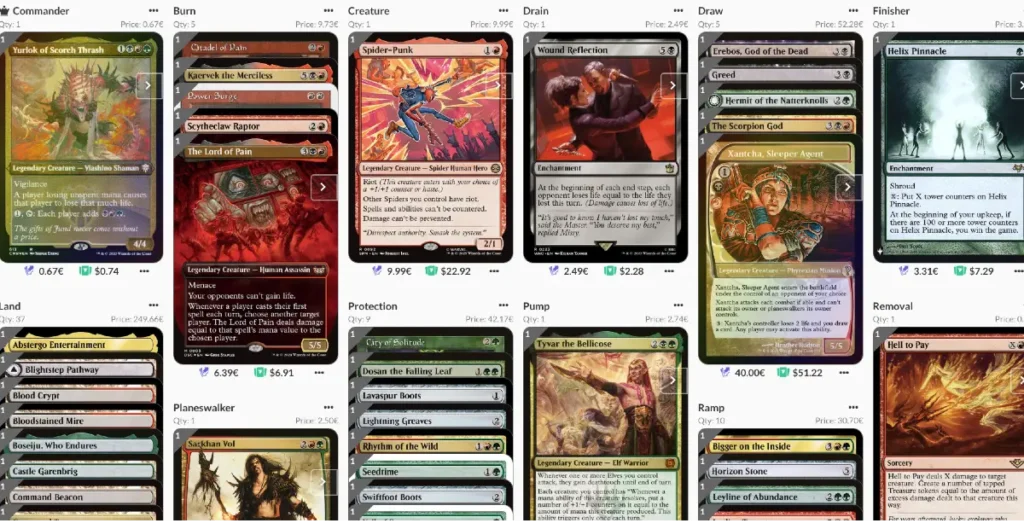
One of the best parts of building your first Commander deck today is that you don’t have to do it alone. There are excellent tools online that make the process easier, whether you’re brainstorming ideas, checking card legality, or tracking your collection.
Deck Building Website
- Archidekt
A super user-friendly deck-building site with drag-and-drop features, price tracking, and even a handy playtest mode where you can try your deck out. It’s great for visual thinkers because it lays everything out neatly by type and cost. - Moxfield
Another excellent deck builder that has quickly become a community favorite. It syncs with EDHREC, so you can see the most commonly played cards for your commander, and it’s fantastic for organizing upgrades to precons.
Both sites also let you share your decklists with friends easily, which is perfect if you want advice or feedback before buying your cards.
Deck Building Apps
- Manabox – iOS and Android
Ideal if you want to manage your decklists and collection on your phone. It’s also a quick way to check prices while you’re browsing singles at a local game store. - TopDecked MTG – iOS and Android
A powerful mobile app that lets you build and test decks, track your collection, and even get metagame insights if you ever branch out into other formats.
Why Use These Tools?
When you’re brand new, it’s easy to underestimate things like your mana curve, ratios of ramp vs. card draw, or even whether a card is legal in Commander. These websites and apps help you catch mistakes early and give you templates to follow so you can focus on the fun part: making the deck yours.
Where to Find Card Ideas
So now you’ve picked your commander, have a good idea of your strategy, and may have even signed up to a deck building tool, but there’s just one thing… how do you even find the best card options for your deck?
When you’re starting out playing commander, the sheer number of Magic cards out there can feel overwhelming. Commander draws from over 30 years of sets, so how do you figure out which cards actually work well in your deck? Luckily, there are two fantastic resources that can make this much easier.
EDHREC
EDHREC is a community-driven database that pulls decklists from players all over the world. When you look up your commander, you’ll see the most commonly played cards alongside it – from staples like Sol Ring to niche synergies that make your commander shine.
- Why it’s useful: You don’t have to reinvent the wheel. If thousands of people are running the same support card with your commander, there’s probably a good reason.
- How to use it: Treat it as a starting point, not a strict recipe. Pick out the cards that fit your budget and playstyle, but don’t feel pressured to copy the top 100% card choices exactly.
Scryfall
Scryfall is the ultimate Magic card search engine. You can filter by color, mana cost, type, rules text, or even keywords. For example, if you’re building a Vampire deck, you can type type:vampire commander:olivia to find cards that fit Olivia’s colors and theme.
- Why it’s useful: It’s the best way to dig deep and find hidden gems that EDHREC might not highlight.
- How to use it: Use the advanced search to look for effects you want more of – like “draw a card,” “destroy target artifact,” or “double tokens.”
Combining the Two
A lot of players (myself included) start on EDHREC to get a sense of what’s popular, then move to Scryfall to customize and refine. Together, they’re an unbeatable combo for finding both staples and unique, personal picks.
Where to Buy Cards From
Once you’ve got a decklist together, the next step is actually getting the cards. This can feel like another big hurdle, but there are a few different ways to go about it – each with its own pros and cons.
Local Game Store (LGS)
Your LGS is often the best place to start.
- Pros: You’ll support your local community, get a chance to browse cards in person, and maybe even meet other Commander players. Many stores also run trade binders or singles cases where you can hand-pick cards.
- Cons: Prices are sometimes higher than online, and the selection may be limited depending on how deep their singles stock is.
Online Stores
Online retailers usually carry a wide range of singles and sealed products.
- Pros: Convenient, fast, and easy to grab most of what you need in one order.
- Cons: Can be pricier overall, especially for in-demand staples, and shipping costs may add up.
Card Marketplaces
Sites that let players sell directly to other players (like Cardmarket in Europe or TCGplayer in the US) often have the lowest prices.
- Pros: Cheapest place to find singles, and you can often get cards in the exact condition you want.
- Cons: You may need to place multiple small orders with different sellers to complete your list, which can mean higher shipping costs or longer wait times.
A Word of Warning: Singles vs. Packs
When you’re just starting out, it’s tempting to buy booster packs or boxes hoping to pull the cards you need. But if your goal is to finish a deck, this is almost always less efficient. Buying singles guarantees you get exactly what you want and will save you money in the long run. Think of packs more as a fun treat, not a reliable way to build your deck.
Conclusion
Building your first Commander deck might seem daunting at first, but it’s also one of the most rewarding parts of Magic. Whether you start with a precon or dive straight into building from scratch, the process teaches you not just about the game, but also about your own playstyle.
Along the way, you’ll learn lessons every Commander player has faced: making sure you’ve got enough lands, realizing your commander won’t always be there to carry you, and discovering that the real magic comes from having a deck that feels like yours. Tools like EDHREC, Scryfall, Archidekt, and Moxfield make it easier than ever to find ideas and organize your list, and with plenty of options for buying singles, you can bring your vision to life without breaking the bank.
Most importantly, don’t stress about getting it perfect the first time. Commander is a format that thrives on iteration – you’ll play games, spot gaps in your deck, swap cards in and out, and slowly refine it into something you’re proud of. My first few builds were messy, overstuffed, and sometimes unplayable, but each one taught me something new.
So pick a commander that excites you, follow the basics of balance and strategy, and start shuffling up. The best way to learn is by playing, and your first deck – flaws and all – will always have a special place in your collection.
